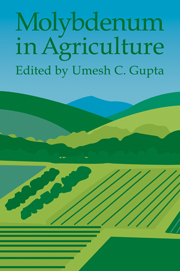Book contents
- Frontmatter
- Contents
- List of contributors
- Preface
- 1 Introduction
- 2 Chemistry and Mineralogy of Molybdenum in Soils
- 3 Distribution and Mobility of Molybdenum in the Terrestrial Environment
- 4 Biochemical Significance of Molybdenum in Crop Plants
- 5 Soil and Plant Factors Affecting Molybdenum Uptake by Plants
- 6 Analytical Techniques for Molybdenum Determination in Plants and Soils
- 7 Testing for Molybdenum Availability in Soils
- 8 Molybdenum Availability in Alkaline Soils
- 9 Deficient, Sufficient, and Toxic Concentrations of Molybdenum in Crops
- 10 Symptoms of Molybdenum Deficiency and Toxicity in Crops
- 11 Sources and Methods for Molybdenum Fertilization of Crops
- 12 Yield Responses to Molybdenum by Field and Horticultural Crops
- 13 Responses of Forage Legumes and Grasses to Molybdenum
- 14 Molybdenum and Sulfur Relationships in Plants
- 15 Molybdenum in the Tropics
- Index
14 - Molybdenum and Sulfur Relationships in Plants
Published online by Cambridge University Press: 10 December 2009
- Frontmatter
- Contents
- List of contributors
- Preface
- 1 Introduction
- 2 Chemistry and Mineralogy of Molybdenum in Soils
- 3 Distribution and Mobility of Molybdenum in the Terrestrial Environment
- 4 Biochemical Significance of Molybdenum in Crop Plants
- 5 Soil and Plant Factors Affecting Molybdenum Uptake by Plants
- 6 Analytical Techniques for Molybdenum Determination in Plants and Soils
- 7 Testing for Molybdenum Availability in Soils
- 8 Molybdenum Availability in Alkaline Soils
- 9 Deficient, Sufficient, and Toxic Concentrations of Molybdenum in Crops
- 10 Symptoms of Molybdenum Deficiency and Toxicity in Crops
- 11 Sources and Methods for Molybdenum Fertilization of Crops
- 12 Yield Responses to Molybdenum by Field and Horticultural Crops
- 13 Responses of Forage Legumes and Grasses to Molybdenum
- 14 Molybdenum and Sulfur Relationships in Plants
- 15 Molybdenum in the Tropics
- Index
Summary
Introduction
The observation that molybdenum (Mo) uptake by plants decreases with increasing concentrations of sulfate was first reported for tomato plants (Lycopersicon esculentum Mill.) in solution culture (Stout and Meagher, 1948). Stout et al. (1951) confirmed that observation with tomato plants grown in tissue culture (Table 14.1) and with tomatoes and peas (Pisum sativum L.) in soil (Tables 14.2 and 14.3). They attributed the action of sulfate ions in suppressing Mo uptake to direct competition between two divalent anions of similar sizes.
Since the report by Stout and co-workers, the effects of sulfur (S) to decrease Mo uptake have been reported in many species grown under a wide range of conditions, including vegetable crops such as beans (Phaseolus vulgaris L.) (Widdowson, 1966), Brussels sprouts (Brassica oleracea L. Gemmifera Group) (Gupta and Cutcliffe, 1968; Gupta, 1969; Gupta and Munro, 1969), cauliflower (Brassica oleracea L. Botrytis Group) (Mulder, 1954), cauliflower and lettuce (Lactuca sativa L.) (Plant, 1956), peas (Reisenauer, 1963; Gupta and Gupta, 1972), and peas and tomatoes (Stout et al. 1951). Similar relations between Mo and S have been found in forages such as berseem (Trifolium alexandrinum L.) (Pasricha and Randhawa, 1972; Shukla and Pathak, 1973; Sisodia, Sawarkar, and Rai, 1975; Pasricha et al., 1977;
- Type
- Chapter
- Information
- Molybdenum in Agriculture , pp. 229 - 244Publisher: Cambridge University PressPrint publication year: 1997
- 10
- Cited by



